Analysis of Surface Urban Heat Island in the Guangzhou-Foshan Metropolitan Area Based on Local Climate Zones
Abstract
:1. Introduction
2. Materials and Methods
2.1. Study Area
2.2. Data Source
2.3. Methods
2.3.1. Local Climate Zones Measurement
2.3.2. Surface Urban Heat Island Measurement
2.3.3. Analysis of Driving Mechanism of SUHI
3. Results
3.1. LCZ Maps
3.2. LST and SUHI of Guangzhou-Foshan Metropolitan Area
3.3. Analysis of SUHI Influential Factors
3.3.1. The Relationship between Local Climate Zones and SUHI Effects
3.3.2. GWR Analysis of SUHI Effect Influential Factors
3.3.3. MGWR Analysis of SUHI Effect Influential Factors
3.3.4. GD Analysis of SUHI Effects Influential Factors
4. Discussion
4.1. The Spatial Heterogeneity of the SUHI Effects
4.2. Analysis of Main Influential Factors of SUHI Effects
4.3. Policy Recommendations to Alleviate SUHI Effects
4.4. Limitation and Future Research Direction
5. Conclusions
Author Contributions
Funding
Data Availability Statement
Acknowledgments
Conflicts of Interest
Abbreviations
| UHI | Urban heat island |
| SUHI | Surface urban heat island |
| SUHII | Surface urban heat island intensity |
| LST | Land surface temperature |
| LCZs | Local climate zones |
| POI | Points of interest |
| DEM | Digital elevation model |
| NDVI | Normalized Difference Vegetation Index |
| NDBI | Normalized Difference Built-up Index |
| NDWI | Normalized Difference Water Index |
| POP | Population Density |
| RD | Road density |
| GDP | Gross Domestic Product |
| NPP | Net Primary Productivity |
| NL | Night light |
| WUDAPT | World Urban Database and Access Portal Tools |
References
- Ward, K.; Lauf, S.; Kleinschmit, B.; Endlicher, W. Heat waves and urban heat islands in Europe: A review of relevant drivers. Sci. Total Environ. 2016, 569, 527–539. [Google Scholar] [CrossRef] [PubMed]
- Cheval, S.; Amihaesei, V.A.; Chitu, Z.; Dumitrescu, A.; Falcescu, V.; Irasoc, A.; Micu, D.M.; Mihulet, E.; Ontel, I.; Paraschiv, M.G.; et al. A systematic review of urban heat island and heat waves research (1991–2022). Clim. Risk Manag. 2024, 44, 100603. [Google Scholar] [CrossRef]
- Oke, T.R. City Size and Urban Heat Island. Atmos. Environ. 1973, 7, 769–779. [Google Scholar] [CrossRef]
- Oke, T.R. The Energetic Basis of the Urban Heat-island. Q. J. R. Meteorol. Soc. 1982, 108, 1–24. [Google Scholar] [CrossRef]
- Abougendia, S.M. Investigating surface UHI using local climate zones (LCZs), the case study of Cairo’s River Islands. Alex. Eng. J. 2023, 77, 293–307. [Google Scholar] [CrossRef]
- Chai, R.M. Relating Urban Morphology and Urban Heat Island During Extreme Heat Events in the Kansas City Metropolitan Area. Ph.D. Thesis, University of Kansas, Lawrence, KS, USA, 2018. [Google Scholar]
- Bureau, P.R. 2023-World-Population-Data-Sheet-Booklet; Population Reference Bureau: Washington, DC, USA, 2023. [Google Scholar]
- Debbage, N.; Shepherd, J.M. The urban heat island effect and city contiguity. Comput. Environ. Urban Syst. 2015, 54, 181–194. [Google Scholar] [CrossRef]
- Peng, W.; Wang, R.; Duan, J.; Gao, W.; Fan, Z. Surface and canopy urban heat islands: Does urban morphology result in the spatiotemporal differences? Urban Clim. 2022, 42, 101136. [Google Scholar] [CrossRef]
- Wen, C.; Mamtimin, A.; Feng, J.; Wang, Y.; Yang, F.; Huo, W.; Zhou, C.; Li, R.; Song, M.; Gao, J.; et al. Diurnal Variation in Urban Heat Island Intensity in Birmingham: The Relationship between Nocturnal Surface and Canopy Heat Islands. Land 2023, 12, 2062. [Google Scholar] [CrossRef]
- Yuan, D.; Zhang, L.; Fan, Y.; Sun, W.; Fan, D.; Zhao, X. Spatio-Temporal Analysis of Surface Urban Heat Island and Canopy Layer Heat Island in Beijing. Appl. Sci. 2024, 14, 5034. [Google Scholar] [CrossRef]
- Mirabi, E.; Davies, P.J. A systematic review investigating linear infrastructure effects on Urban Heat Island (UHIULI) and its interaction with UHI typologies. Urban Clim. 2022, 45, 101261. [Google Scholar] [CrossRef]
- Lin, J.; Wei, K.; Guan, Z. Exploring the connection between morphological characteristic of built-up areas and surface heat islands based on MSPA. Urban Clim. 2024, 53, 101764. [Google Scholar] [CrossRef]
- Jung, W.; Kim, G. Reduction of Fine Dust and Alleviation of Heat Island Effect: An Analysis of Cold Air Flow in Pohang City, South Korea. Land 2024, 13, 347. [Google Scholar] [CrossRef]
- Kang, S.; Lee, D.; Park, J.; Jung, J. Exploring Urban Forms Vulnerable to Urban Heat Islands: A Multiscale Analysis. Sustainability 2022, 14, 3603. [Google Scholar] [CrossRef]
- Zhang, J.; Tu, L.; Wang, X.; Liang, W. Comparison of Urban Heat Island Differences in the Yangtze River Delta Urban Agglomerations Based on Different Urban-Rural Dichotomies. Remote Sens. 2024, 16, 3206. [Google Scholar] [CrossRef]
- Badaro-Saliba, N.; Adjizian-Gerard, J.; Zaarour, R.; Najjar, G. LCZ scheme for assessing Urban Heat Island intensity in a complex urban area (Beirut, Lebanon). Urban Clim. 2021, 37, 100846. [Google Scholar] [CrossRef]
- Muhammad, F.; Xie, C.K.; Vogel, J.; Afshari, A. Inference of Local Climate Zones from GIS Data, and Comparison to WUDAPT Classification and Custom-Fit Clusters. Land 2022, 11, 747. [Google Scholar] [CrossRef]
- Xi, Y.; Wang, S.; Zou, Y.; Zhou, X.; Zhang, Y. Seasonal surface urban heat island analysis based on local climate zones. Ecol. Indic. 2024, 159, 111669. [Google Scholar] [CrossRef]
- Yin, S.; Xiao, S.Y.; Ding, X.T.; Fan, Y.F. Improvement of spatial-temporal urban heat island study based on local climate zone framework: A case study of Hangzhou, China. Build. Environ. 2024, 248, 111102. [Google Scholar] [CrossRef]
- Zhang, J.; Tu, L.; Shi, B. Spatiotemporal Patterns of the Application of Surface Urban Heat Island Intensity Calculation Methods. Atmosphere 2023, 14, 1580. [Google Scholar] [CrossRef]
- Qin, Y.; Ghalambaz, S.; Sheremet, M.; Baro, M.; Ghalambaz, M. Deciphering Urban Heat Island Mitigation: A Comprehensive Analysis of Application Categories and Research Trends. Sustain. Cities Soc. 2024, 101, 105081. [Google Scholar] [CrossRef]
- Shi, L.; Ling, F.; Foody, G.M.; Yang, Z.; Liu, X.; Du, Y. Seasonal SUHI Analysis Using Local Climate Zone Classification: A Case Study of Wuhan, China. Int. J. Environ. Res. Public Health 2021, 18, 7242. [Google Scholar] [CrossRef]
- Han, J.; Liu, J.; Liu, L.; Ye, Y. Spatiotemporal Changes in the Urban Heat Island Intensity of Distinct Local Climate Zones: Case Study of Zhongshan District, Dalian, China. Complexity 2020, 2020, 8820338. [Google Scholar] [CrossRef]
- Hu, J.; Yang, Y.; Pan, X.; Zhu, Q.; Zhan, W.; Wang, Y.; Ma, W.; Su, W. Analysis of the Spatial and Temporal Variations of Land Surface Temperature Based on Local Climate Zones: A Case Study in Nanjing, China. IEEE J. Sel. Top. Appl. Earth Obs. Remote Sens. 2019, 12, 4213–4223. [Google Scholar] [CrossRef]
- Bechtel, B.; Demuzere, M.; Mills, G.; Zhan, W.; Sismanidis, P.; Small, C.; Voogt, J. SUHI analysis using Local Climate Zones-A comparison of 50 cities. Urban Clim. 2019, 28, 100451. [Google Scholar] [CrossRef]
- Eldesoky, A.H.M.; Gil, J.; Pont, M.B. The suitability of the urban local climate zone classification scheme for surface temperature studies in distinct macroclimate regions. Urban Clim. 2021, 37, 100823. [Google Scholar] [CrossRef]
- Kamath, H.G.; Martilli, A.; Singh, M.; Brooks, T.; Lanza, K.V.; Bixler, R.P.; Coudert, M.; Yang, Z.L.; Niyogi, D. Human heat health index (H3I) for holistic assessment of heat hazard and mitigation strategies beyond urban heat islands. Urban Clim. 2023, 52, 101675. [Google Scholar] [CrossRef]
- Moon, S.Y.; Kim, J.; Chong, W.K.O.; Ariaratnam, S.T. Urban Green Space Layouts and Urban Heat Island: Case Study on Apartment Complexes in South Korea. J. Urban Plan. Dev. 2018, 144, 04018004. [Google Scholar] [CrossRef]
- Li, D.; Yan, S.F.; Chen, G.Z. Effects of Urban Redevelopment on Surface Urban Heat Island. IEEE J. Sel. Top. Appl. Earth Obs. Remote Sens. 2023, 16, 2366–2373. [Google Scholar] [CrossRef]
- Iamtrakul, P.; Padon, A.; Chayphong, S. Quantifying the Impact of Urban Growth on Urban Surface Heat Islands in the Bangkok Metropolitan Region, Thailand. Atmosphere 2024, 15, 100. [Google Scholar] [CrossRef]
- Ramírez-Aguilar, E.A.; Souza, L.C.L. Urban form and population density: Influences on Urban Heat Island intensities in Bogota, Colombia. Urban Clim. 2019, 29, 100497. [Google Scholar] [CrossRef]
- Murayama, Y.; Wang, R.C. Editorial: Special Issue on Geographical Analysis and Modeling of Urban Heat Island Formation. Remote Sens. 2023, 15, 4474. [Google Scholar] [CrossRef]
- Meng, F.; Yan, S.L.; Tian, G.H.; Wang, Y.D. Surface urban heat island effect and its spatiotemporal dynamics in metropolitan area: A case study in the Zhengzhou metropolitan area, China. Front. Environ. Sci. 2023, 11, 1247046. [Google Scholar] [CrossRef]
- Kim, H.; Seok, H.B.; Kim, Y.K. A Study on the Change of the Urban Heat Island Structure in Busan Metropolitan Area, Korea. J. Environ. Sci. Int. 2014, 23, 1807–1820. [Google Scholar] [CrossRef]
- Yu, Z.W.; Yao, Y.W.; Yang, G.Y.; Wang, X.R.; Vejre, H. Spatiotemporal patterns and characteristics of remotely sensed region heat islands during the rapid urbanization (1995-2015) of Southern China. Sci. Total Environ. 2019, 674, 242–254. [Google Scholar] [CrossRef]
- Song, Y.; Wang, J.; Ge, Y.; Xu, C. An optimal parameters-based geographical detector model enhances geographic characteristics of explanatory variables for spatial heterogeneity analysis: Cases with different types of spatial data. GIScience Remote Sens. 2020, 57, 593–610. [Google Scholar] [CrossRef]
- Yu, H.; Fotheringham, A.S.; Li, Z.; Oshan, T.; Kang, W.; Wolf, L.J. Inference in Multiscale Geographically Weighted Regression. Geogr. Anal. 2020, 52, 87–106. [Google Scholar] [CrossRef]
- Meng, L.; Zhu, C.G.; Pu, J.; Wen, B.; Si, W.T. Study on the Influence Mechanism of Intangible Cultural Heritage Distribution from Man-Land Relationship Perspective: A Case Study in Shandong Province. Land 2022, 11, 1225. [Google Scholar] [CrossRef]
- Huang, Y.; Lang, W.; Chen, T.T.; Wu, J.M. Regional Coordinated Development in the Megacity Regions: Spatial Pattern and Driving Forces of the Guangzhou-Foshan Cross-Border Area in China. Land 2023, 12, 753. [Google Scholar] [CrossRef]
- Ye, Y.Q.; Zhang, J.E.; Bryan, B.A.; Gao, L.; Qin, Z.; Chen, L.L.; Yang, J.Y. Impacts of rapid urbanization on ecosystem services along urban-rural gradients: A case study of the Guangzhou-Foshan Metropolitan Area, South China. Ecoscience 2018, 25, 235–247. [Google Scholar] [CrossRef]
- Malakar, N.K.; Hulley, G.C.; Hook, S.J.; Laraby, K.; Cook, M.; Schott, J.R. An Operational Land Surface Temperature Product for Landsat Thermal Data: Methodology and Validation. IEEE Trans. Geosci. Remote Sens. 2018, 56, 5717–5735. [Google Scholar] [CrossRef]
- Park, S.H.; Jung, H.S.; Shin, H.S. Time-series monitoring result of land surface temperature variation at Mt. Baekdu using Landsat images. In Proceedings of the Conference on Land Surface Remote Sensing II, Beijing, China, 13–16 October 2014. [Google Scholar]
- Li, S.J.; Cao, X.; Zhao, C.C.; Jie, N.; Liu, L.L.; Chen, X.H.; Cui, X.H. Developing a Pixel-Scale Corrected Nighttime Light Dataset (PCNL, 1992-2021) Combining DMSP-OLS and NPP-VIIRS. Remote Sens. 2023, 15, 3925. [Google Scholar] [CrossRef]
- Demuzere, M.; Kittner, J.; Bechtel, B. LCZ Generator: A Web Application to Create Local Climate Zone Maps. Front. Environ. Sci. 2021, 9, 637455. [Google Scholar] [CrossRef]
- Vaidya, M.; Keskar, R.; Kotharkar, R. Classifying heterogeneous urban form into local climate zones using supervised learning and greedy clustering incorporating Landsat dataset. Urban Clim. 2024, 53, 101770. [Google Scholar] [CrossRef]
- Zhao, N.; Ma, A.; Zhong, Y.; Zhao, J.; Cao, L. Self-Training Classification Framework with Spatial-Contextual Information for Local Climate Zones. Remote Sens. 2019, 11, 2828. [Google Scholar] [CrossRef]
- Yang, Y.M.; Qiu, J.X.; Su, H.B.; Bai, Q.M.; Liu, S.H.; Li, L.; Yu, Y.L.; Huang, Y.X. A One-Source Approach for Estimating Land Surface Heat Fluxes Using Remotely Sensed Land Surface Temperature. Remote Sens. 2017, 9, 43. [Google Scholar] [CrossRef]
- Cai, M.; Ren, C.; Xu, Y. Investigating the relationship between local climate zone and land surface temperature—A case study in Shanghai. In Proceedings of the Joint Urban Remote Sensing Event (JURSE), Dubai, United Arab Emirates, 6–8 March 2017. [Google Scholar]
- Nasehi, S.; Yavari, A.; Salehi, E.; Emmanuel, R. Role of local climate zone and space syntax on land surface temperature (case study: Tehran). Urban Clim. 2022, 45, 101245. [Google Scholar] [CrossRef]
- Quan, J.L. Diurnal land surface temperature characteristics of local climate zones: A case study in beijing, china. In Proceedings of the IEEE International Geoscience and Remote Sensing Symposium (IGARSS), Yokohama, Japan, 28 July–2 August 2019; pp. 7443–7446. [Google Scholar]
- Hong, S.-O.; Kim, D.-H.; Byon, J.-Y.; Park, H.; Ha, J.-C. Analysis of the Effects of Advection and Urban Fraction on Urban Heat Island Intensity using Unified Model for Seoul Metropolitan Area, Korea. Atmosphere 2019, 29, 381–390. [Google Scholar] [CrossRef]
- Bechtel, B.; Alexander, P.J.; Beck, C.; Boehner, J.; Brousse, O.; Ching, J.; Demuzere, M.; Fonte, C.; Gal, T.; Hidalgo, J.; et al. Generating WUDAPT Level 0 data—Current status of production and evaluation. Urban Clim. 2019, 27, 24–45. [Google Scholar] [CrossRef]
- Alghamdi, A.S.; Alzhrani, A.I.; Alanazi, H.H. Local Climate Zones and Thermal Characteristics in Riyadh City, Saudi Arabia. Remote Sens. 2021, 13, 4526. [Google Scholar] [CrossRef]
- Huang, F.; Jiang, S.D.; Zhan, W.F.; Bechtel, B.; Liu, Z.H.; Demuzere, M.; Huang, Y.; Xu, Y.; Ma, L.; Xia, W.J.; et al. Mapping local climate zones for cities: A large review. Remote Sens. Environ. 2023, 292, 113573. [Google Scholar] [CrossRef]
- Perera, N.G.R.; Emmanuel, R. A “Local Climate Zone” based approach to urban planning in Colombo, Sri Lanka. Urban Clim. 2018, 23, 188–203. [Google Scholar] [CrossRef]
- Xu, D.; Zhang, Q.; Zhou, D.; Yang, Y.J.; Wang, Y.Q.; Rogora, A.; Pitts, A. Local Climate Zone in Xi’an City: A Novel Classification Approach Employing Spatial Indicators and Supervised Classification. Buildings 2023, 13, 2806. [Google Scholar] [CrossRef]
- Xu, Y.N.; Hou, W.; Zhang, C.X. Spatial Association Rules and Thermal Environment Differentiation Evaluation of Local Climate Zone and Urban Functional Zone. Land 2023, 12, 1701. [Google Scholar] [CrossRef]
- Schonlau, M.; Zou, R.Y. The random forest algorithm for statistical learning. Stata J. 2020, 20, 3–29. [Google Scholar] [CrossRef]
- dos Anjos, C.S.; Lacerda, M.G.; Andrade, L.D.; Salles, R.N. Classification of urban environments using feature extraction and random forest. In Proceedings of the IEEE International Geoscience and Remote Sensing Symposium (IGARSS), Fort Worth, TX, USA, 23–28 July 2017; pp. 1205–1208. [Google Scholar]
- Sekertekin, A.; Bonafoni, S. Land Surface Temperature Retrieval from Landsat 5, 7, and 8 over Rural Areas: Assessment of Different Retrieval Algorithms and Emissivity Models and Toolbox Implementation. Remote Sens. 2020, 12, 294. [Google Scholar] [CrossRef]
- Garcia, D.H.; Diaz, J.A. Modeling of the Urban Heat Island on local climatic zones of a city using Sentinel 3 images: Urban determining factors. Urban Clim. 2021, 37, 100840. [Google Scholar] [CrossRef]
- Zhang, W.; Huo, H.; Geng, X.; Zhou, P.; Guo, L.; Li, Z.-L. Simulation of canopy urban heat island at a block scale based on local climate zones and urban weather generator: A case study of Beijing. Int. J. Remote Sens. 2023. early access. [Google Scholar] [CrossRef]
- Li, C.; Zhang, N.; Wang, Y.; Chen, Y. Modeling Urban Heat Islands and Thermal Comfort During a Heat Wave Event in East China With CLM5 Incorporating Local Climate Zones. J. Geophys. Res.-Atmos. 2023, 128, e2023JD038883. [Google Scholar] [CrossRef]
- Lin, Z.; Xu, H.; Yao, X.; Yang, C.; Yang, L. Exploring the relationship between thermal environmental factors and land surface temperature of a “furnace city” based on local climate zones. Build. Environ. 2023, 243, 110732. [Google Scholar] [CrossRef]
- Zhang, H.; Wang, C.; Yang, H.; Ma, Z. How do morphology factors affect urban heat island intensity? an approach of local climate zones in a fast-growing small city, Yangling, China. Ecol. Indic. 2024, 161, 111972. [Google Scholar] [CrossRef]
- Liu, W.; Zhang, L.; Hu, X.; Meng, Q.; Qian, J.; Gao, J.; Li, T. Nonlinear effects of urban multidimensional characteristics on daytime and nighttime land surface temperature in highly urbanized regions: A case study in Beijing, China. Int. J. Appl. Earth Obs. Geoinf. 2024, 132, 104067. [Google Scholar] [CrossRef]
- Sarricolea, P.; Smith, P.; Romero-Aravena, H.; Serrano-Notivoli, R.; Fuentealba, M.; Meseguer-Ruiz, O. Socioeconomic inequalities and the surface heat island distribution in Santiago, Chile. Sci. Total Environ. 2022, 832, 155152. [Google Scholar] [CrossRef] [PubMed]
- Wu, Z.; Xu, Y.; Cao, Z.; Yang, J.; Zhu, H. Impact of Urban Agglomeration and Physical and Socioeconomic Factors on Surface Urban Heat Islands in the Pearl River Delta Region, China. IEEE J. Sel. Top. Appl. Earth Obs. Remote Sens. 2021, 14, 8815–8822. [Google Scholar] [CrossRef]
- Chen, G.; Wei, Z. Exploring the impacts of built environment on bike-sharing trips on weekends: The case of Guangzhou. Int. J. Sustain. Transp. 2024, 18, 315–327. [Google Scholar] [CrossRef]
- Bechtel, B.; See, L.; Mills, G.; Foley, M. Classification of Local Climate Zones Using SAR and Multispectral Data in an Arid Environment. IEEE J. Sel. Top. Appl. Earth Obs. Remote Sens. 2016, 9, 3097–3105. [Google Scholar] [CrossRef]
- Liao, C.M.; Zuo, Y.F.; Law, R.; Wang, Y.Y.; Zhang, M. Spatial Differentiation, Influencing Factors, and Development Paths of Rural Tourism Resources in Guangdong Province. Land 2022, 11, 2046. [Google Scholar] [CrossRef]
- Yuan, W.R.; Chen, L.K.; Chen, H.X.; Deng, S.F.; Ji, H.; Liang, F.S. Assessing habitat quality at Poyang Lake based on InVEST and Geodetector modeling. Ecol. Evol. 2023, 13, e10759. [Google Scholar] [CrossRef] [PubMed]
- Lu, Y.; Yang, J.; Ma, S. Dynamic Changes of Local Climate Zones in the Guangdong-Hong Kong-Macao Greater Bay Area and Their Spatio-Temporal Impacts on the Surface Urban Heat Island Effect between 2005 and 2015. Sustainability 2021, 13, 6374. [Google Scholar] [CrossRef]
- Xiang, Y.; Zheng, B.; Bedra, K.B.; Ouyang, Q.; Liu, J.; Zheng, J. Spatial and seasonal differences between near surface air temperature and land surface temperature for Urban Heat Island effect assessment. Urban Clim. 2023, 52, 101745. [Google Scholar] [CrossRef]
- Zhao, Z.; Sharifi, A.; Dong, X.; Shen, L.; He, B.-J. Spatial Variability and Temporal Heterogeneity of Surface Urban Heat Island Patterns and the Suitability of Local Climate Zones for Land Surface Temperature Characterization. Remote Sens. 2021, 13, 4338. [Google Scholar] [CrossRef]
- Wang, Z.H.; Xing, W.; Huang, Y.; Xie, T.A. Studying the Urban Heat Island Using a Local Climate Zone Scheme. Pol. J. Environ. Stud. 2016, 25, 2609–2616. [Google Scholar] [CrossRef] [PubMed]
- Tian, W.S.; Yang, Y.J.; Wang, L.L.; Zong, L.; Zhang, Y.H.; Liu, D.Y. Role of local climate zones and urban ventilation in canopy urban heat island-heatwave interaction in Nanjing megacity, China. Urban Clim. 2023, 49, 101474. [Google Scholar] [CrossRef]
- Ma, L.; Huang, G.A.; Johnson, B.A.; Chen, Z.J.; Li, M.C.; Yan, Z.Y.; Zhan, W.F.; Lu, H.; He, W.Q.; Lian, D.J. Investigating urban heat-related health risks based on local climate zones: A case study of Changzhou in China. Sustain. Cities Soc. 2023, 91, 104402. [Google Scholar] [CrossRef]
- Shen, Y.; Zeng, C.; Cheng, Q.; Shen, H.F. Opposite Spatiotemporal Patterns for Surface Urban Heat Island of Two “Stove Cities” in China: Wuhan and Nanchang. Remote Sens. 2021, 13, 4447. [Google Scholar] [CrossRef]
- Deng, X.D.; Gao, F.; Liao, S.Y.; Liu, Y.; Chen, W.Y. Spatiotemporal evolution patterns of urban heat island and its relationship with urbanization in Guangdong-Hong Kong-Macao greater bay area of China from 2000 to 2020. Ecol. Indic. 2023, 146, 109817. [Google Scholar] [CrossRef]
- Guo, A.; Yang, J.; Xiao, X.; Xia, J.; Jin, C.; Li, X. Influences of urban spatial form on urban heat island effects at the community level in China. Sustain. Cities Soc. 2020, 53, 101972. [Google Scholar] [CrossRef]
- Huang, Y.; Yuan, M.; Lu, Y. Spatially varying relationships between surface urban heat islands and driving factors across cities in China. Environ. Plan. B-Urban Anal. City Sci. 2019, 46, 377–394. [Google Scholar] [CrossRef]
- Wang, L.; Hou, H.; Weng, J. Ordinary least squares modelling of urban heat island intensity based on landscape composition and configuration: A comparative study among three megacities along the Yangtze River. Sustain. Cities Soc. 2020, 62, 102381. [Google Scholar] [CrossRef]
- Wang, X.; Zhou, T.; Tao, F.; Zang, F. Correlation Analysis between UBD and LST in Hefei, China, Using Luojia1-01 Night-Time Light Imagery. Appl. Sci. 2019, 9, 5224. [Google Scholar] [CrossRef]
- Chen, P. Inequality in heat: The role of spatial patterns of urban green infrastructure. Urban Clim. 2024, 53, 101820. [Google Scholar] [CrossRef]
- Lan, Y.L.; Zhan, Q.M. How do urban buildings impact summer air temperature? The effects of building configurations in space and time. Build. Environ. 2017, 125, 88–98. [Google Scholar] [CrossRef]
- Wang, Y.S.; Zhan, Q.M.; Ouyang, W.L. How to quantify the relationship between spatial distribution of urban waterbodies and land surface temperature? Sci. Total Environ. 2019, 671, 1–9. [Google Scholar] [CrossRef] [PubMed]
- Wu, C.Y.; Li, J.X.; Wang, C.F.; Song, C.H.; Chen, Y.; Finka, M.; La Rosa, D. Understanding the relationship between urban blue infrastructure and land surface temperature. Sci. Total Environ. 2019, 694, 133742. [Google Scholar] [CrossRef]
- Xu, Z.Y.; Zhao, S.Q. Scale dependence of urban green space cooling efficiency: A case study in Beijing metropolitan area. Sci. Total Environ. 2023, 898, 165563. [Google Scholar] [CrossRef] [PubMed]
- Zölch, T.; Maderspacher, J.; Wamsler, C.; Pauleit, S. Using green infrastructure for urban climate-proofing: An evaluation of heat mitigation measures at the micro-scale. Urban For. Urban Green. 2016, 20, 305–316. [Google Scholar] [CrossRef]
- Asadi, A.; Arefi, H.; Fathipoor, H. Simulation of green roofs and their potential mitigating effects on the urban heat island using an artificial neural network: A case study in Austin, Texas. Adv. Space Res. 2020, 66, 1846–1862. [Google Scholar] [CrossRef]
- Chenary, K.; Soltani, A.; Sharifi, A. Street network patterns for mitigating urban heat islands in arid climates. Int. J. Digit. Earth 2023, 16, 3145–3161. [Google Scholar] [CrossRef]
- Irie, T. The cooling effect of green infrastructure in mitigating nocturnal urban heat islands: A case study of Yoyogi Park and Meiji Jingu Shrine in Tokyo. Landsc. Res. 2022, 47, 559–583. [Google Scholar] [CrossRef]
- Qian, W.Q.; Li, X.Y. A cold island connectivity and network perspective to mitigate the urban heat island effect. Sustain. Cities Soc. 2023, 94, 104525. [Google Scholar] [CrossRef]
- Wong, M.M.F.; Fung, J.C.H.; Ching, J.; Yeung, P.P.S.; Tse, J.W.P.; Ren, C.; Wang, R.; Cai, M. Evaluation of uWRF performance and modeling guidance based on WUDAPT and NUDAPT UCP datasets for Hong Kong. Urban Clim. 2019, 28, 100460. [Google Scholar] [CrossRef]
- Zonato, A.; Martilli, A.; Di Sabatino, S.; Zardi, D.; Giovanni, L. Evaluating the performance of a novel WUDAPT averaging technique to define urban morphology with mesoscale models. Urban Clim. 2020, 31, 100584. [Google Scholar] [CrossRef]
- Daemei, A.B.; Bradecki, T.; Pancewicz, A.; Razzaghipour, A.; Jamali, A.; Abbaszadegan, S.M.; Askarizad, R.; Kazemi, M.; Sharifi, A. An experimental analysis and deep learning model to assess the cooling performance of green walls in humid climates. Front. Energy Res. 2024, 12, 1447655. [Google Scholar] [CrossRef]
- Tanoori, G.; Soltani, A.; Modiri, A. Machine Learning for Urban Heat Island (UHI) Analysis: Predicting Land Surface Temperature (LST) in Urban Environments. Urban Clim. 2024, 55, 101962. [Google Scholar] [CrossRef]


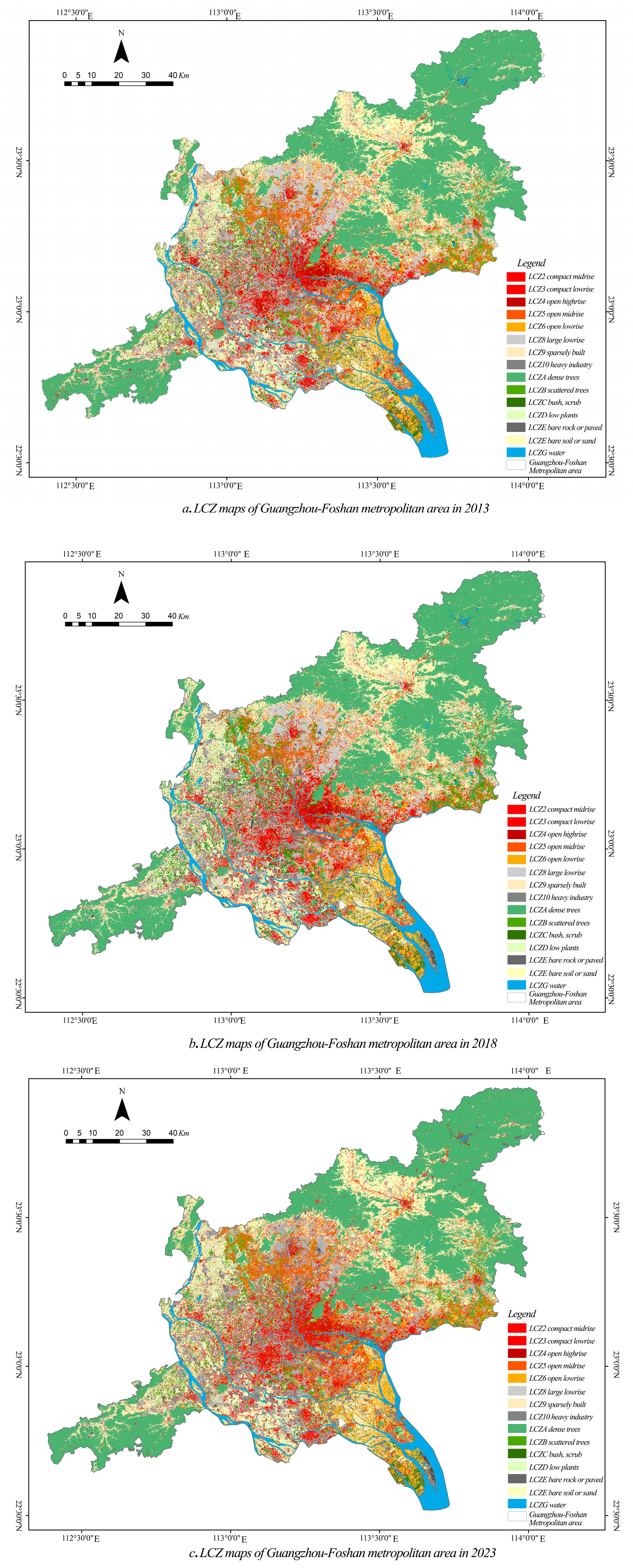
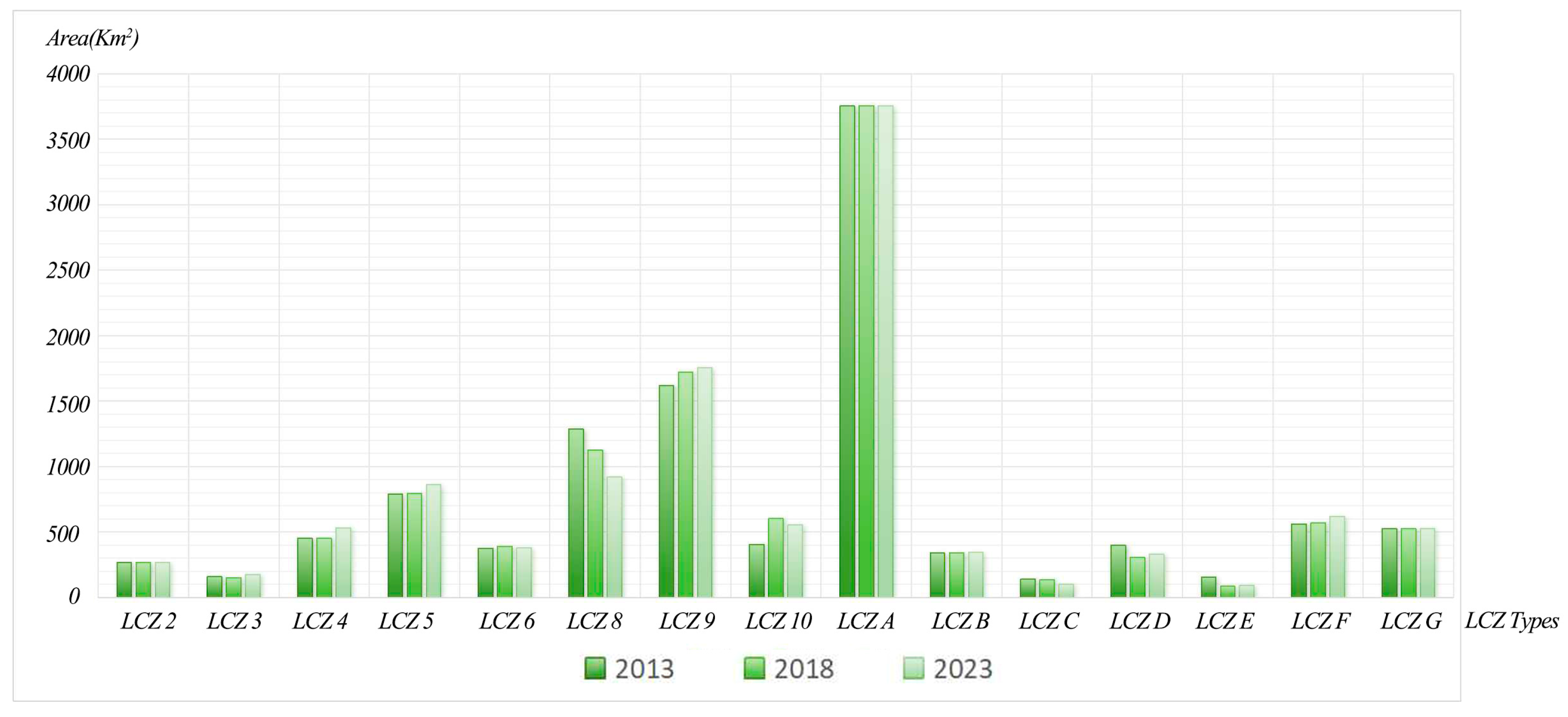
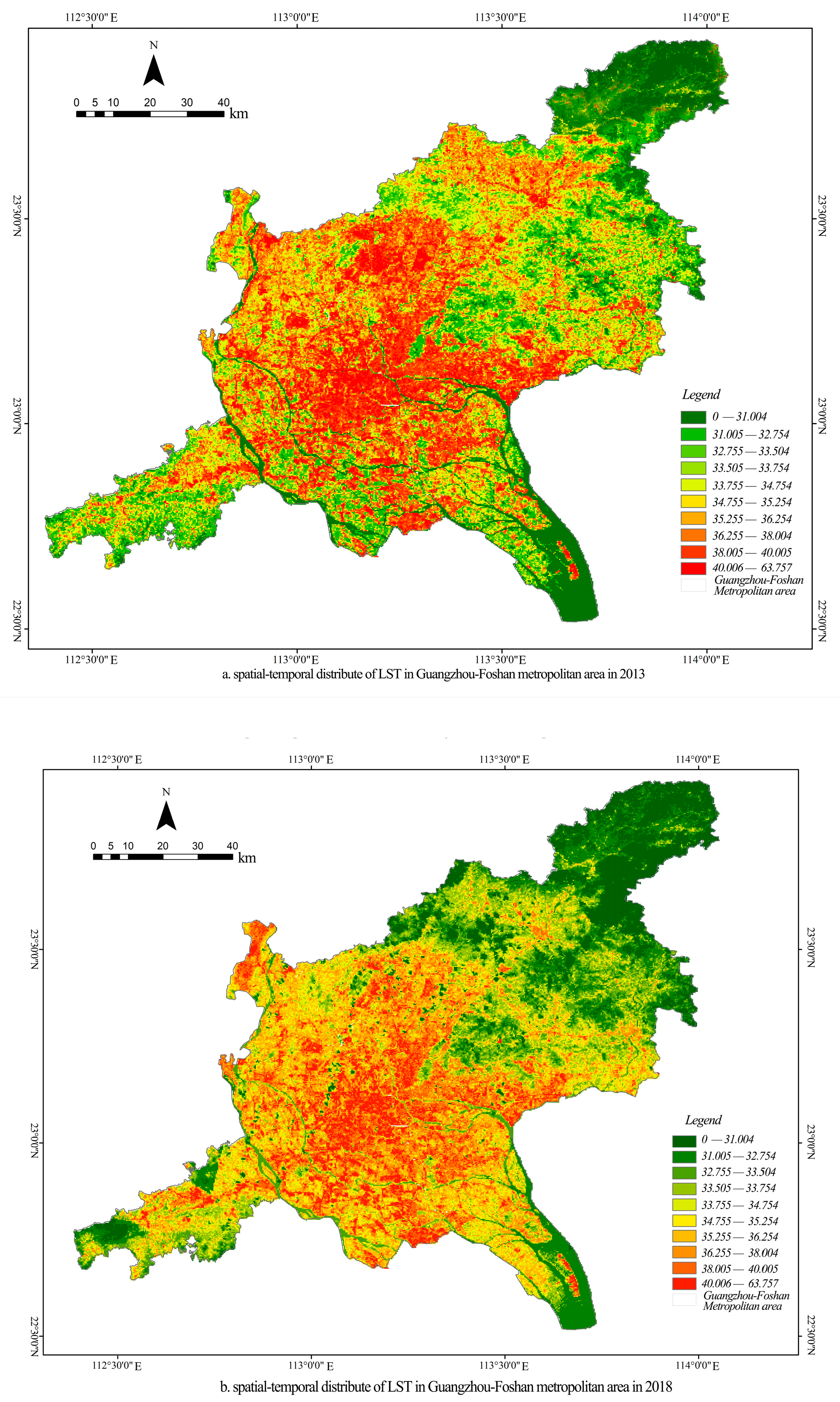
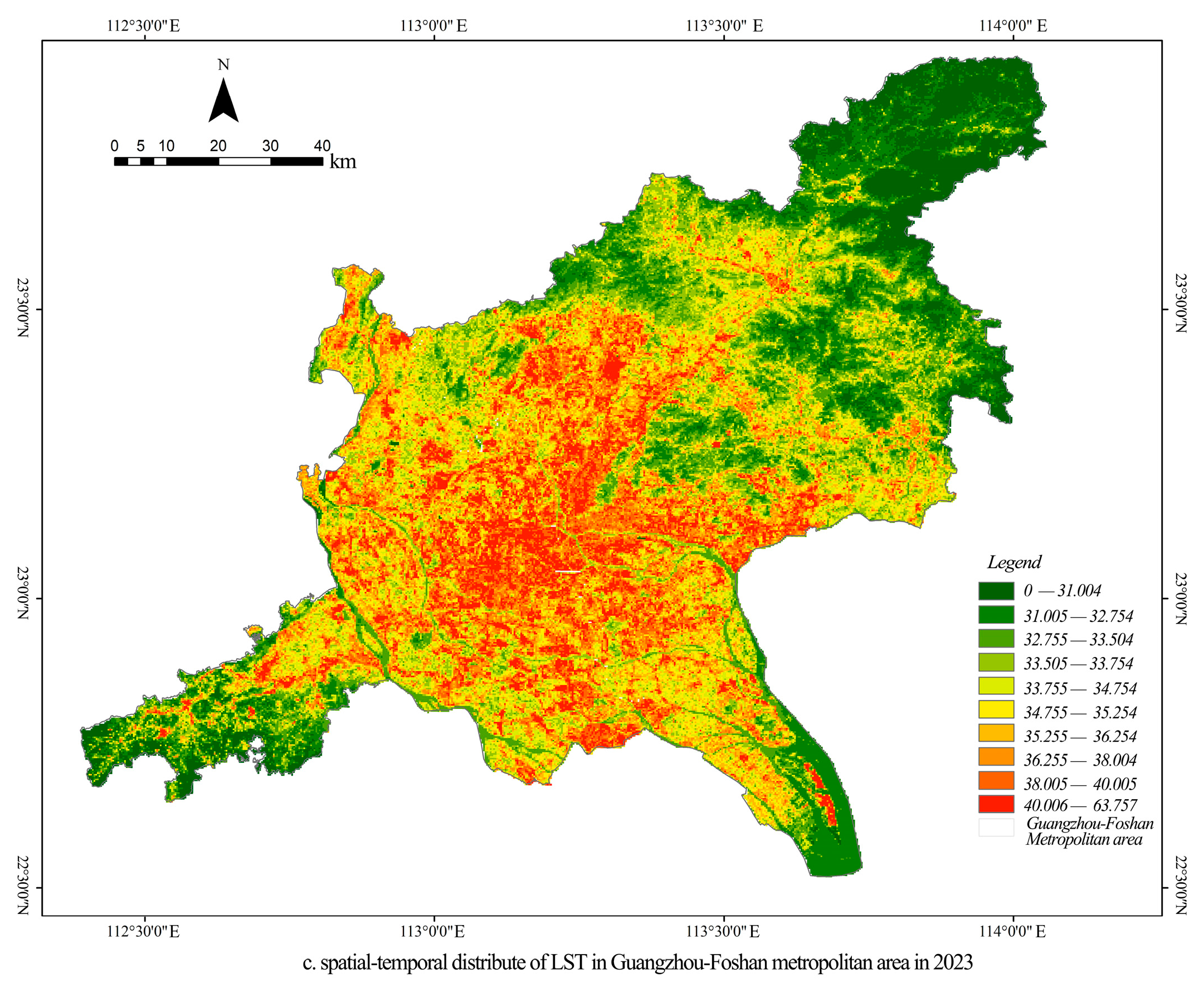

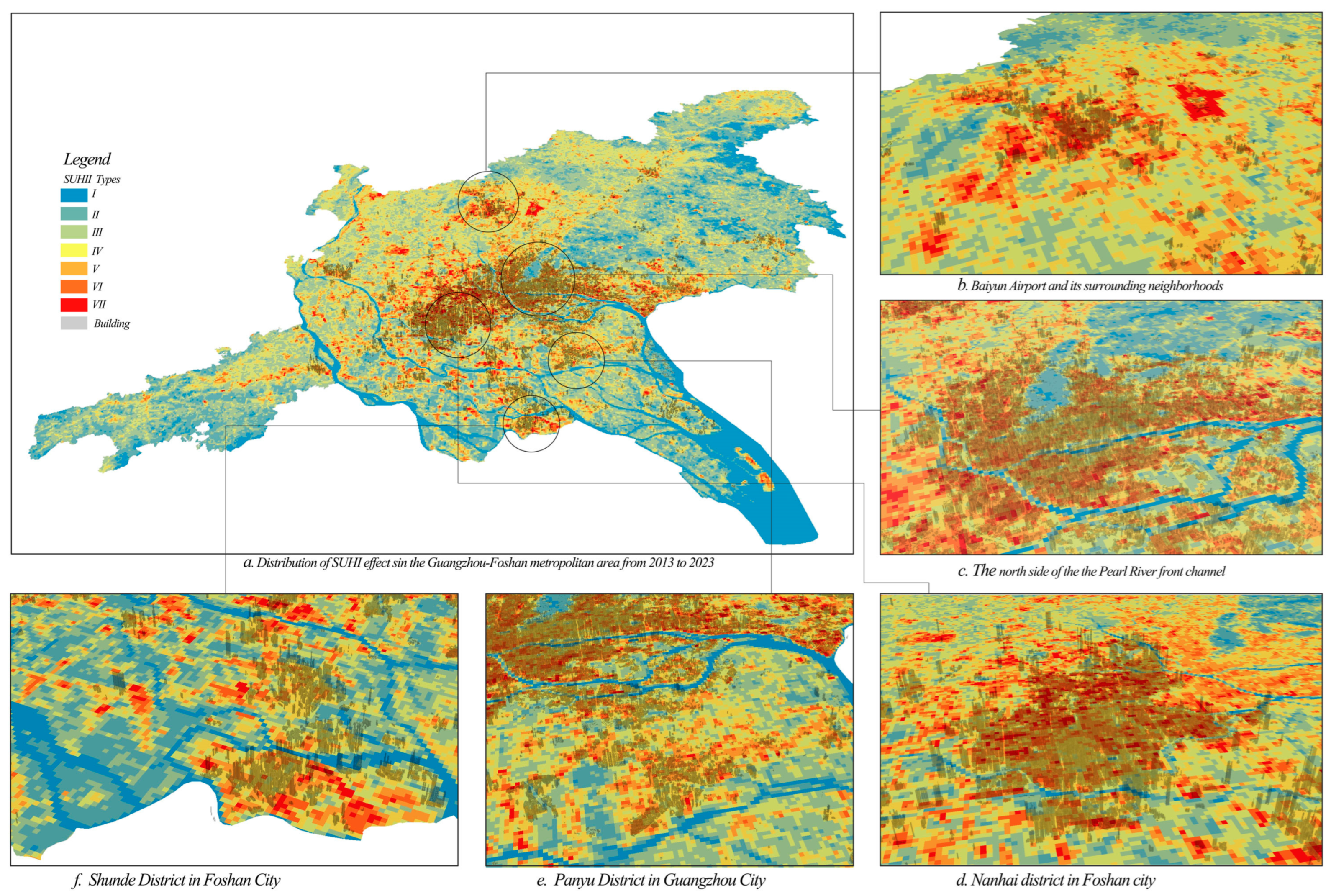
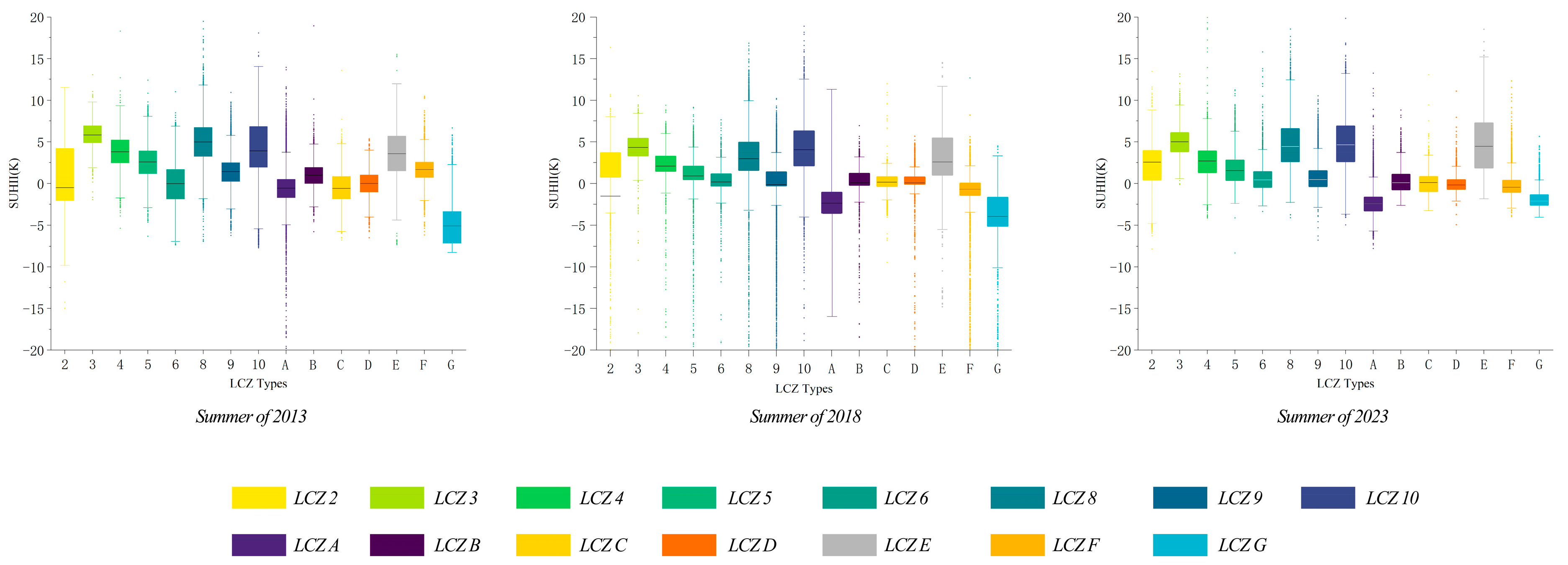

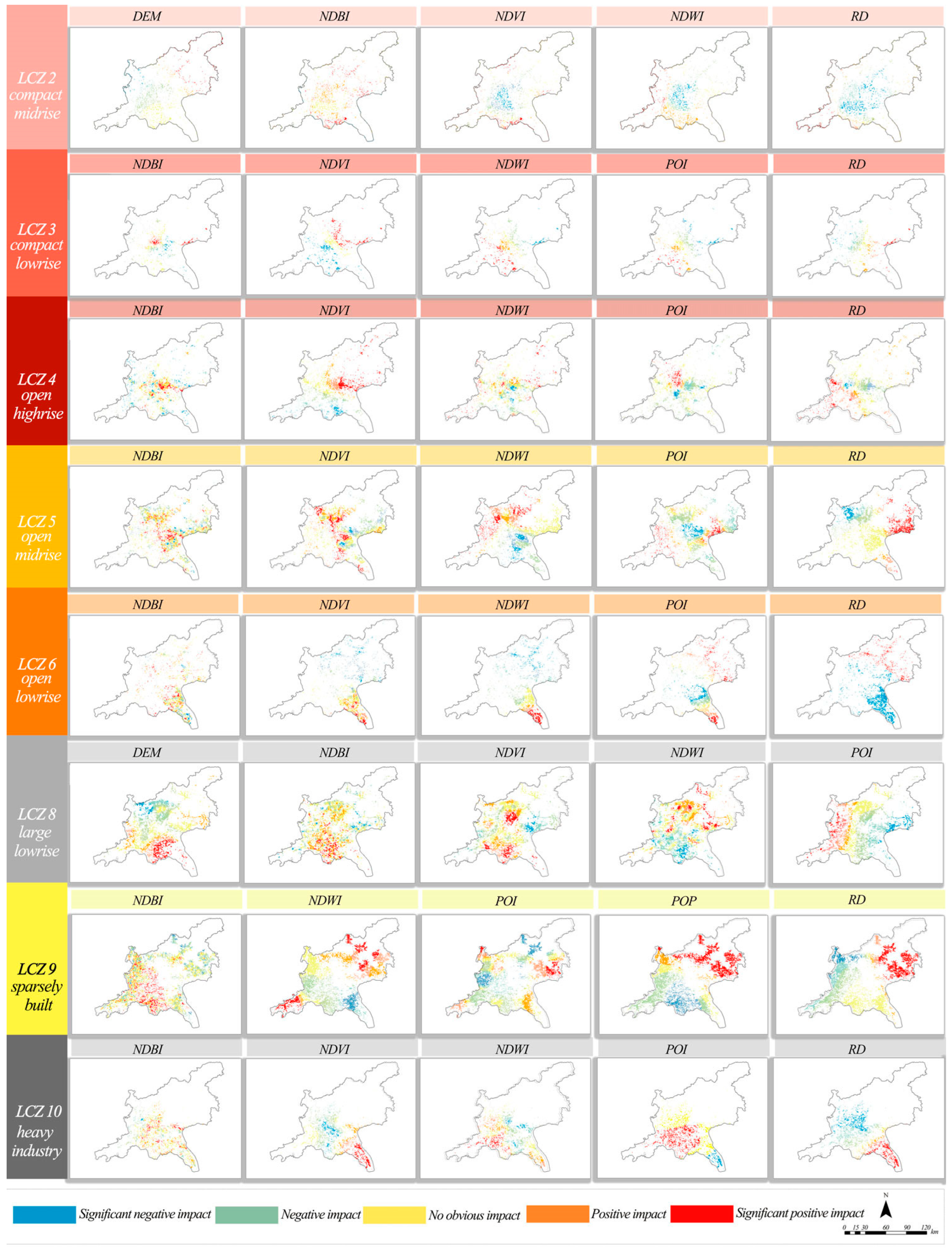
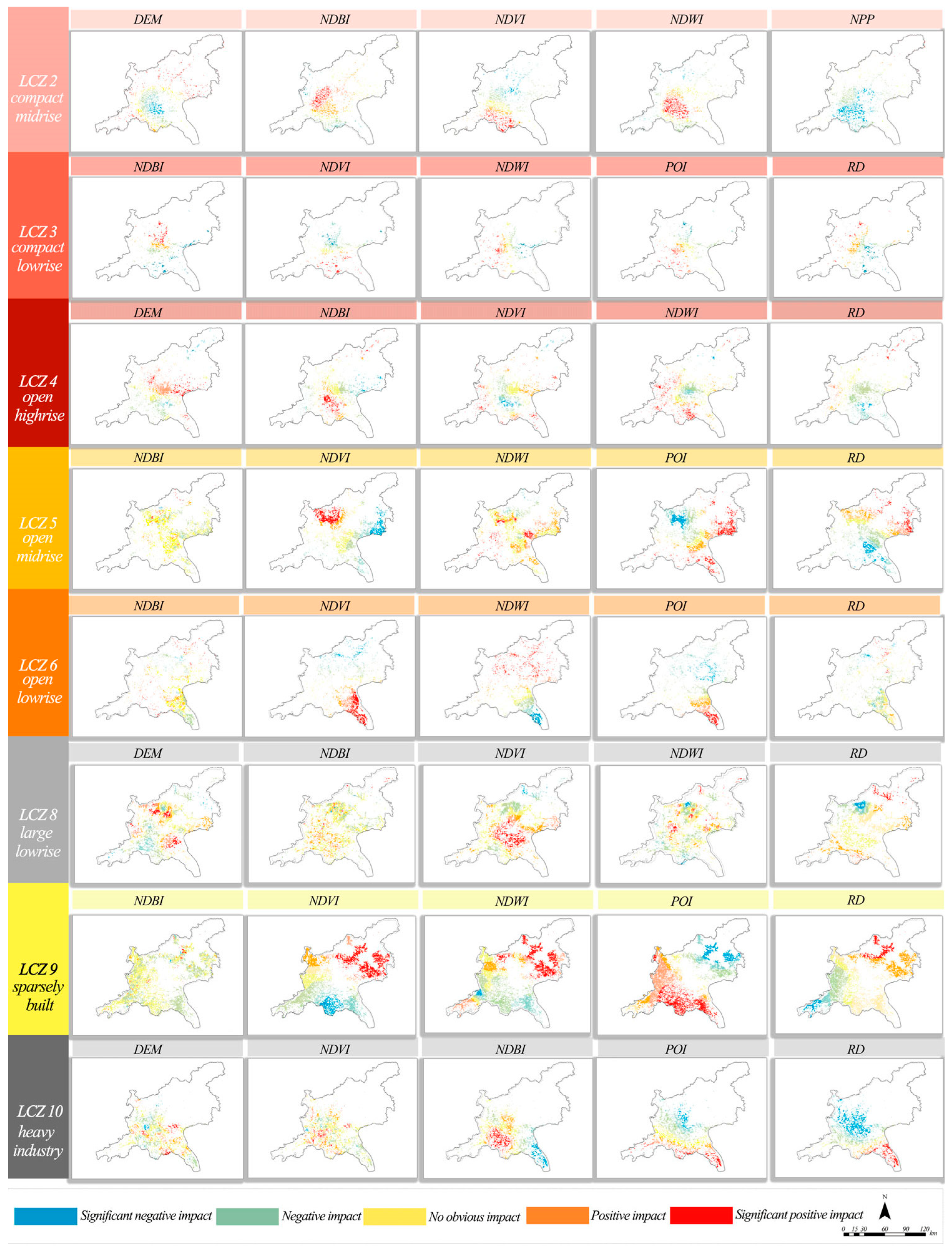

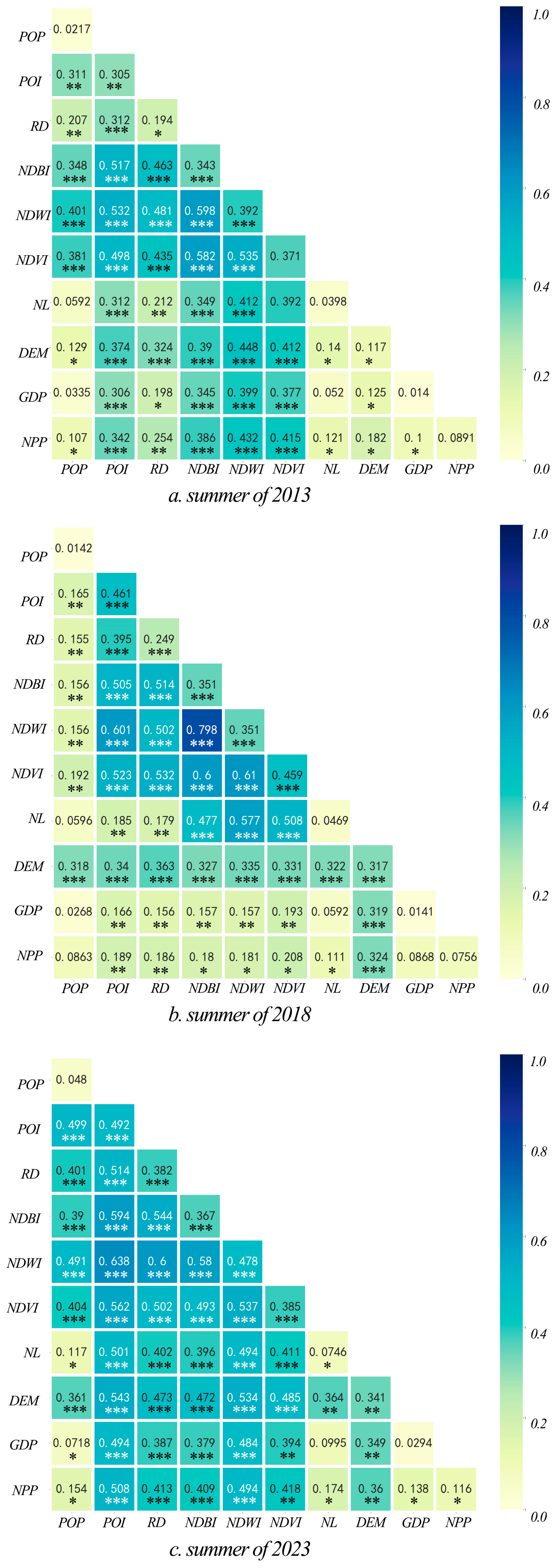
| Data | Date | Type | Spatial Resolution | Source |
|---|---|---|---|---|
| Landsat images | 13 June 2013 3 August 2013 12 July 2018 11 August 2018 15 June 2023 22 June 2023 | Raster | 30 m × 30 m | USGS (https://landsat.visibleearth.nasa.gov, accessed on 4 October 2024) |
| Road network | 2013 2018 2023 | Vector | Open Street Map (http://www.openstreetmap.org, accessed on 4 October 2024) | |
| Digital elevation model | 2013 | Raster | 30 m × 30 m | NASA (https://www.earthdata.nasa.gov, accessed on 4 October 2024) |
| Points of interest (POI) | 2013 2018 2023 | Vector | Amap (https://www.amap.com, accessed on 4 October 2024) | |
| LUCC | 2013 2018 2023 | Raster | 30 m × 30 m | Chinese Academy of Science (https://www.resdc.cn/DOI, accessed on 4 October 2024) |
| Nighttime light images | 2013 2018 2023 | Raster | 30 m × 30 m | DMSP-OLS dataset (https://dataverse.harvard.edu/dataset.xhtml?persistentId=doi:10.7910/DVN/GIYGJU, accessed on 4 October 2024) |
| Population/GDP | 2013 2018 2023 | Raster | 30 m × 30 m | <China Urban Statistical Yearbook> etc. |
| Built Types | Land Cover Types | ||
|---|---|---|---|
| LCZ Types | Training Sample Example | LCZ Types | Training Sample Example |
| LCZ 2 compact midrise | 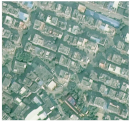 | LCZ A dense trees | 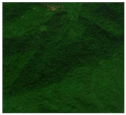 |
| LCZ 3 compact lowrise | 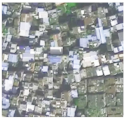 | LCZ B scattered trees |  |
| LCZ 4 open highrise | 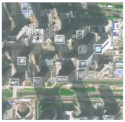 | LCZ C bush, scrub |  |
| LCZ 5 open midrise | 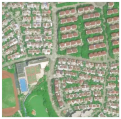 | LCZ D low plants |  |
| LCZ 6 open lowrise | 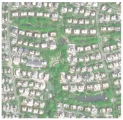 | LCZ E bare rock or paved | 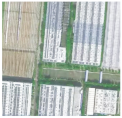 |
| LCZ 8 large lowrise | 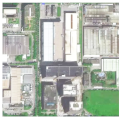 | LCZ F bare soil or sand | 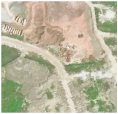 |
| LCZ 9 sparsely built |  | LCZ G water | 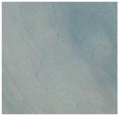 |
| LCZ 10 heavy industry | 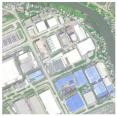 | ||
| Types | Indicators | Formula | Description |
|---|---|---|---|
| Land cover factors | NDVI | (NIR − R)/(NIR + R) | NIR: infrared reflectance; R: red band reflectance |
| NDBI | (SWIR − NIR)/(SWIR + NIR) | SWIR: Short wave infrared reflectance; NIR: Infrared reflectance | |
| NDWI | (Green − NIR)/(Green + NIR) | Green: Green light band; NIR: Infrared reflectance | |
| NPP | GPP − R | GPP: Gross Primary Productivity; R: The loss of plant respiration | |
| Urban environmental factors | POI kernel density | Where k is the kernel function, h is the smoothing parameter, X is the POI point, and is the sample observation point. | |
| Road Density (RD) | Where D is the line density value, n is the number of lines within the grid point search radius, L is the length of the lines, V is the weight of the lines, and A is the search area centered on the grid point. | ||
| DEM | — | — | |
| Nighttime light | — | — | |
| Social-economic factors | Population density | — | — |
| GDP | — | — |
| Types | Formula | Degree of Influence |
|---|---|---|
| nonlinear enhancement | X2) > q(X1) + q(X2) | Strong |
| independent | X2) = q(X1) + q(X2) | Relatively Strong |
| linear enhancement | X2) > Max(q(X1), q(X2)) | Average |
| weakening | X2) < Max(q(X1),q(X2)) | Relatively weak |
| nonlinear attenuation | X2) < Min(q(X1),q(X2)) | weak |
| Years | 2013 | 2018 | 2023 |
|---|---|---|---|
| LCZ Types | Area (km2) | ||
| 2 | 267.162 | 267.806 | 267.381 |
| 3 | 157.042 | 151.017 | 174.357 |
| 4 | 450.274 | 450.236 | 530.831 |
| 5 | 786.609 | 791.185 | 860.761 |
| 6 | 375.630 | 388.973 | 377.779 |
| 8 | 1285.022 | 1125.337 | 917.980 |
| 9 | 1618.563 | 1718.923 | 1755.408 |
| 10 | 403.269 | 601.363 | 553.087 |
| A | 3753.009 | 3757.327 | 3757.472 |
| B | 337.218 | 338.616 | 346.711 |
| C | 138.346 | 133.454 | 98.515 |
| D | 397.150 | 304.506 | 329.785 |
| E | 152.330 | 83.679 | 90.305 |
| F | 558.028 | 567.559 | 619.909 |
| G | 524.774 | 524.445 | 524.145 |
| SUHII Types | Area (2013) km2 | Percentage (2013) | Area (2018) km2 | Percentage (2018) | Area (2023) km2 | Percentage (2023) |
|---|---|---|---|---|---|---|
| VII (Super strong heat island) | 391.49 | 3.44% | 399.46 | 3.51% | 412.38 | 3.62% |
| VI (Strong heat island) | 814.76 | 7.15% | 595.91 | 5.23% | 562.59 | 4.94% |
| V (Normal heat island) | 1515.06 | 13.30% | 938.43 | 8.24% | 1069.11 | 9.39% |
| IV (Weak heat island) | 2511.27 | 22.05% | 2184.93 | 19.18% | 1857.24 | 16.31% |
| III (No heat island) | 3261.69 | 28.64% | 3510.9 | 30.83% | 3054.96 | 26.82% |
| II (Weak cold island) | 1749.15 | 15.36% | 1656.36 | 14.54% | 3130.38 | 27.49% |
| I (Strong cold island) | 1145.99 | 10.06% | 2103.42 | 18.73% | 1302.75 | 11.44% |
Disclaimer/Publisher’s Note: The statements, opinions and data contained in all publications are solely those of the individual author(s) and contributor(s) and not of MDPI and/or the editor(s). MDPI and/or the editor(s) disclaim responsibility for any injury to people or property resulting from any ideas, methods, instructions or products referred to in the content. |
© 2024 by the authors. Licensee MDPI, Basel, Switzerland. This article is an open access article distributed under the terms and conditions of the Creative Commons Attribution (CC BY) license (https://creativecommons.org/licenses/by/4.0/).
Share and Cite
He, X.; Yuan, Q.; Qin, Y.; Lu, J.; Li, G. Analysis of Surface Urban Heat Island in the Guangzhou-Foshan Metropolitan Area Based on Local Climate Zones. Land 2024, 13, 1626. https://doi.org/10.3390/land13101626
He X, Yuan Q, Qin Y, Lu J, Li G. Analysis of Surface Urban Heat Island in the Guangzhou-Foshan Metropolitan Area Based on Local Climate Zones. Land. 2024; 13(10):1626. https://doi.org/10.3390/land13101626
Chicago/Turabian StyleHe, Xiaxuan, Qifeng Yuan, Yinghong Qin, Junwen Lu, and Gang Li. 2024. "Analysis of Surface Urban Heat Island in the Guangzhou-Foshan Metropolitan Area Based on Local Climate Zones" Land 13, no. 10: 1626. https://doi.org/10.3390/land13101626
APA StyleHe, X., Yuan, Q., Qin, Y., Lu, J., & Li, G. (2024). Analysis of Surface Urban Heat Island in the Guangzhou-Foshan Metropolitan Area Based on Local Climate Zones. Land, 13(10), 1626. https://doi.org/10.3390/land13101626






